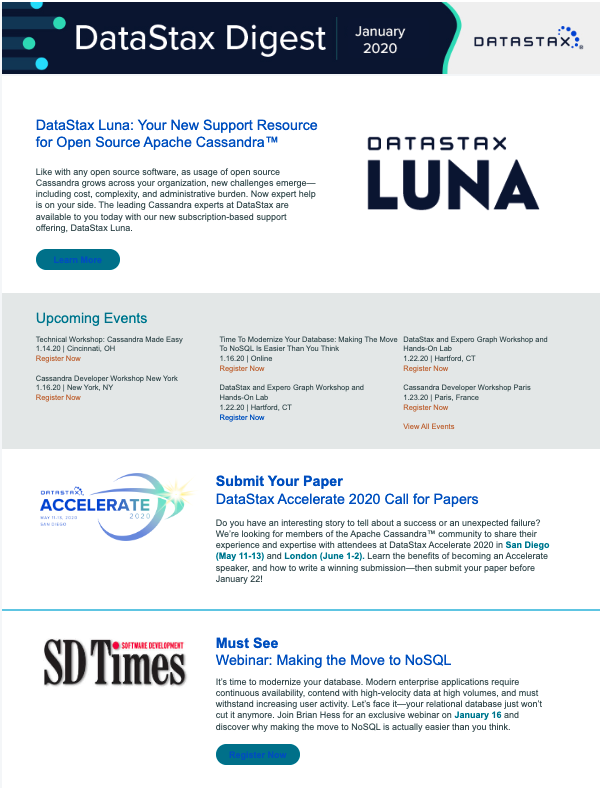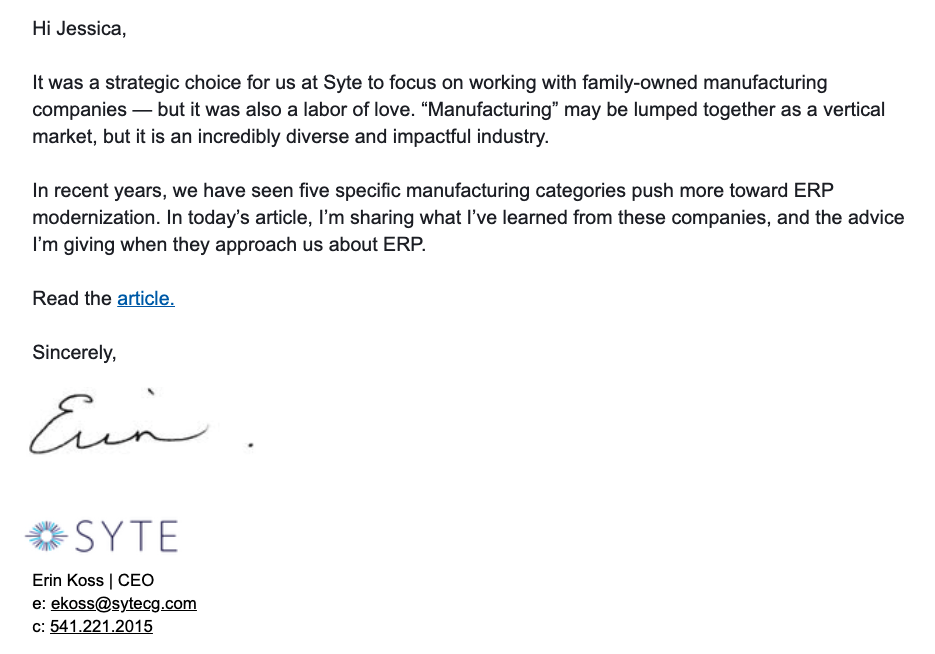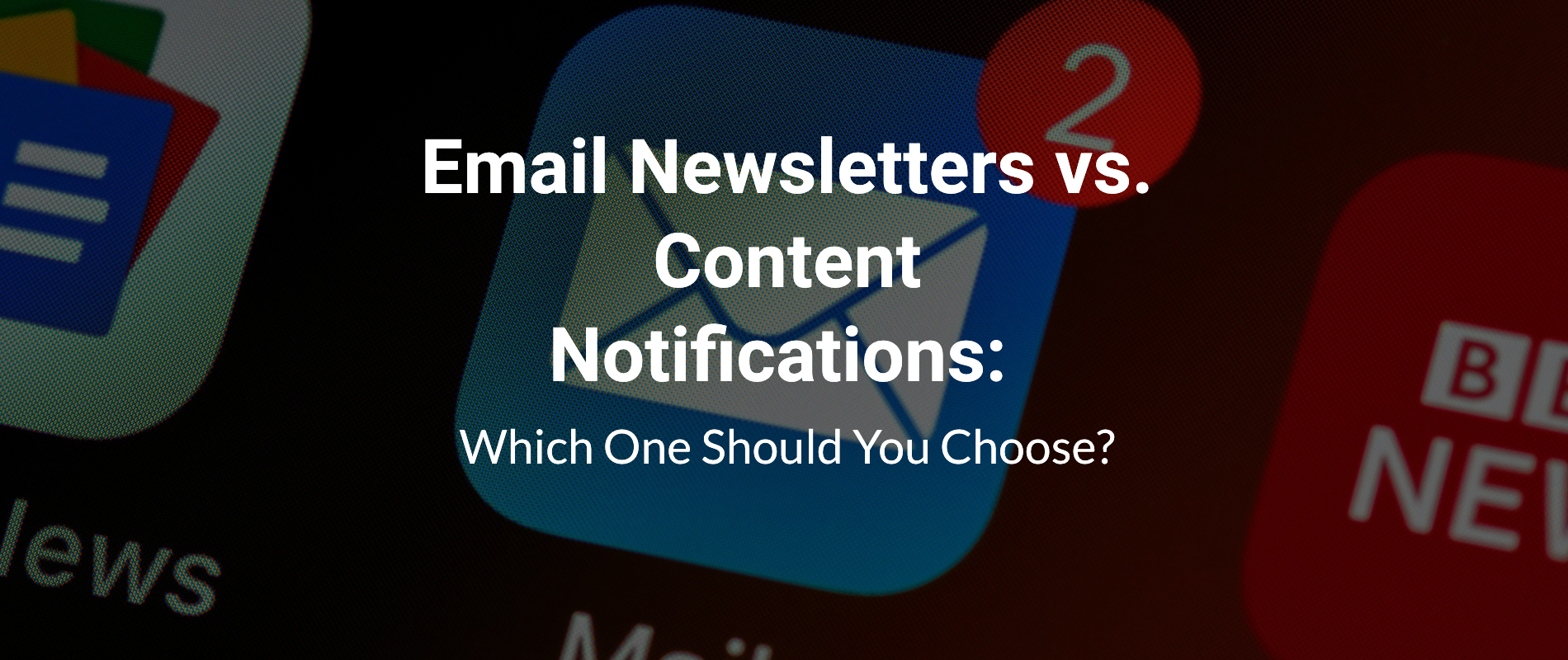This is a guest article written by Horizon Peak senior copywriter Beth Hayden. Beth has been a conversion copywriter for 15 years, specializing in technical and complex content for technology companies.
To be successful with email marketing, you can’t take your foot off the gas after you convert a website visitor to a subscriber.
Having an email subscriber on your list doesn’t do your enterprise technology company any good if you don’t nurture the relationship with that contact, so your company stays top of mind when they need a product or service like yours.
So what’s the key to building relationships with your email subscribers? The key is regularly sending email messages that provide useful, valuable content — and thoughtfully share your company’s unique selling proposition (USP) with subscribers.
Here’s what many marketing organizations don’t realize: Not all emails are created equal.
You have several options for sending out regular communications, but the most common are email newsletters and content notifications. You can use either of these methods to get useful content into the hands of your subscribers, so you can build your authority and help people understand how you can solve their problems.
What are the differences between email newsletters and content notifications, and which one should you choose for your company? Let’s look at the definition of these two methods and examine the pros and cons of each to help you decide.
Option 1: Send an Email Newsletter
Marketing teams typically publish email newsletters on a regular schedule (usually weekly or monthly). The content includes a branded HTML header, an opening greeting, and a featured article or a collection of articles. That’s not a hard and fast rule, but many newsletters follow this format.
A newsletter may include links to the company’s published content, curated content from other sources, images or special offers. Imagine a newsletter as a collection of different items of interest to the reader (versus a stand-alone message that only focuses on one thing).
DataStax, for example, publishes a monthly newsletter with links to featured articles, upcoming events, and webinars.

The benefits of newsletters
Fixed publishing schedules can be motivating. If your audience expects your newsletter every Wednesday, presumably you will be more motivated to get that message out the door consistently.
You have the flexibility to send a variety of content. The newsletter format enables you to share different kinds of content, and you’ll have plenty of room for links from your archive, featured content from partners, images and so forth.
You may have lower unsubscribe rates. Because your reader will expect messages from you — and will be used to seeing your company regularly in their inbox — presumably they’ll be less likely to hit that “unsubscribe” button, particularly if you consistently send relevant, useful content.
The disadvantages of newsletters
Your team could feel pressure to publish on a set schedule. If it causes stress for your people to be on the hook to publish weekly or monthly, being on a set schedule could be demotivating.
Newsletters can take longer to format. Including a variety of content, like articles, images and links to curated content, may make formatting your newsletter time-consuming. Even with the most user-friendly email service providers, your newsletter format will require some finagling and you may need to send several test messages before you hit that final “send” button.
Some content could get lost. When you publish a variety of content in every message, some of your readers may miss important announcements or links. And some subscribers, even if they love your newsletter, may not have time to read it in its entirety every week.
Option 2: Send Notifications With Links to Your Latest Content
The other way to stay in touch with your list is to send an email broadcast (aka “email blast”) whenever you publish a new piece of content like a blog post, video or podcast episode.
Your email might be:
- A “teaser” that includes only a short excerpt of the content, with a link to read or consume the entire piece
- A message that includes the entire article in the body of the email (if your content is text-based).
For example, Syte Consulting Group sends out content notifications to their list when they publish new articles or videos.

The benefits of content notifications
Your emails will be more focused. Each content notification message is focused on one goal — to get the subscriber to read or consume a single piece of content. All the links and calls to action in the email will be aimed at that goal, making it less likely that something important will get lost in the shuffle.
Content notification emails may be faster to create. Short content notification emails — particularly if they are text-only or if they use a simple email template — may take less time and energy to create.
The disadvantages of content notifications
Your email schedule may be inconsistent. If you don’t publish content on a regular basis, you may end up emailing your list less often. That may lead to higher unsubscribe rates when you do send a broadcast, because your subscribers won’t remember who you are or why they signed up for your list.
You could send emails too frequently. This may not be a big problem long-term, but if you transition from only sending a monthly newsletter to emailing twice a week, you can expect more short-term unsubscribes from your list.
Getting Your Audience to Fall in Love With Your Emails
The good news is that you don’t have to choose between sending an email newsletter and publishing content notifications. If both methods work for your content creation schedule and your team, there’s no reason you can’t do both.
But focusing on one method or the other can also work for your enterprise tech marketing. It depends on your team, your goals, and your audience.
No matter which method you choose, the most important thing is that you communicate with your list regularly and reliably send them high-quality content they can’t wait to receive. That’s the secret to email marketing success at the enterprise level.
